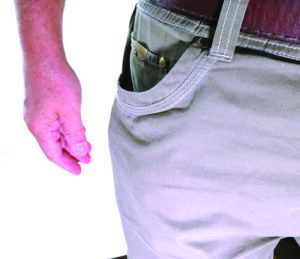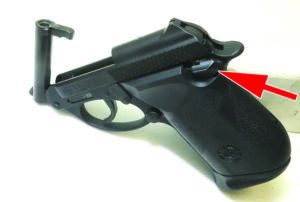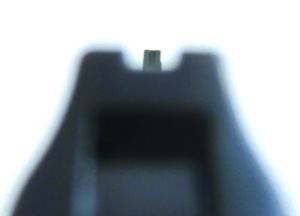An email from Gun Tests reader Jim T. asked for a 22 LR subcompact concealed-carry pistol match up, specifically mentioning the old-school Walther TPH and Ruger LCP II. We winced at the thought because the 22 LR is not an adequate defense round, in our estimation. There are better caliber choices, but 22 LR subcompact pistols are popular and have been since the 1920s. We added two additional subcompacts — a Taurus PT-22 and Beretta 21A Bobcat — to round out the list. Though these mouse guns lack power, they do offer deep concealment and surprise. These are close-quarter guns to be used an arm’s length away, perhaps incapacitating or intimidating your attacker so you can run away to safety or to get a bigger gun.
How We Tested
All of these pistols have short barrels less than 3 inches in length and have tiny, rudimentary sights. Because they are small, they tend to get lost in your hand. There is not a lot to hang onto. Slides are small with minimal serrations, especially in the case of the Taurus and Beretta, and that makes them difficult to operate. The Ruger LCP II was specially designed for ease of slide retraction. Safety levers are also minuscule, as are the magazines, which can be a pain to load.
We accuracy tested at 10 yards, using our range bag as a rest, and found the pea-shooters had good accuracy. We used Thompson Targets Sight-Seer Red targets for accuracy testing. For speed shooting, we performed the Failure Drill — two shots to center of mass, one shot to the head — at 7 yards and found all of these guns performed well and could easily be used to defend yourself. We tested speed using a Thompson Target B27STOP Upper Torso Silhouette Target, which has immobilization zones outlined on the sheet.

Now here’s the “but”: Getting a semi-automatic 22 LR pistol to run consistently is a challenge. There is an embarrassment of 22 LR bullet weights and styles, and some work better than others, depending on the pistol. We would definitely run a lot of 22 LR ammo through these mousey guns to find consistency before we pocketed any of them for defense. With the new guns — Beretta 21A Bobcat, Taurus PT-22, ad Ruger LCP II — we experienced FTF (failures to feed) jams and some FTE (failures to eject) jams, especially in early accuracy testing. The bullet shape makes a big difference on whether the ammo will feed or not. The Winchester Silvertip ammo gave us the most mishaps, and that could be because it uses a larger 37-grain bullet compared to the 30-grain and 29-grain bullets used in the Aguila and Federal ammo, respectively. As we ran ammo through them, they performed more consistently, so keep in mind there is a break-in period for the mouse guns.
We also concealed-carried these pistols in our pocket, using an Elite Survival System Pocket holster PH-1L ($18; EliteSurvival.com), which has a no-slip outside texture that “sticks” to the inside of your pants pocket and allows you to easily draw the pistol. The Ruger LCP II came with a similar style holster, which we thought was added value. All of these mouse guns were easy to carry concealed and simply felt like a wallet in our front pocket.
Test ammo for the mouse guns consisted of two defense loads that on paper make a mouse gun roar: Winchester Silvertips with a 37-grain plated segmenting hollow point bullet and Federal Punch, a 29-grain flat-point solid bullet. We also tested Aguila’s amped-up Supermaximum rounds with a 30-grain copper-plated solid bullet. With 22 LR ammo, you want a bullet to penetrate as much as possible for terminal performance. Heavy clothing and body mass will slow down a 22 LR, which means less penetration. Here are the details.
Gun Test Grade: B+
$250
The TP-22 is the middle-class relative to the affluent Beretta family. While based on the Beretta 21 Bobcat design, the Taurus is different. The frame is polymer, and the grip is much fatter in hand. In fact, it fills the voids the Ruger and Beretta grip have. The Taurus also has an American-friendly magazine-release button located under a right-hand shooter’s shooting-hand thumb. Isn’t that where all magazine release buttons should be? The magazine does not fall free; you need to pull it out of the grip via the extended floor plate. There is a load-assist button built into the magazine. We used the button to compress the magazine spring as we dropped the rounds in, base first. The last round in required that we push the bullet between the magazine lips, much like on a centerfire pistol magazine. Not the easiest-loading magazine, but we soon got the hang of it.
| Action | Semi-automatic, blowback, hammer fired |
| Trigger | Double action only |
| Overall Length | 5.2 in. |
| Overall Height | 4.3 in. |
| Maximum Width | 1.1 in. |
| Weight Unloaded | 11.1 oz. |
| Weight Loaded | 12.0 oz. |
| Barrel Length | 2.3 in. |
| Capacity | 8+1 (single stack) |
| Slide | Black, steel |
| Slide Retraction Effort | 15.0 lbs. |
| Frame | Black, polymer |
| Frame Front Strap Height | 2.2 in. |
| Frame Back Strap Height | 2.7 in. |
| Grip | Textured polymer |
| Grip Thickness (max) | 1.1 in. |
| Grip Circumference (max) | 5.0 in. |
| Sights | Integral |
| Trigger Pull Weight | 8.5 lbs. |
| Trigger Span | 2.8 in. |
| Magazines | 1; steel |
| Manual Safety | Magazine, thumb |
| Warranty | Limited lifetime |
| Website | TaurusUSA.com |
| Made In | USA |
The Taurus uses a simple blowback design without an extractor or a slide stop. The sights are small but easier to use than the Beretta’s sights because the Taurus front-sight blade is larger, it has a slot in it to reduce glare, and the rear notch is larger.

Like the Beretta, the PT-22 has an open-slide design and tip-up barrel feature that allows for loading the chamber directly. When you press the barrel back into shooting position, you need to flick the lever to lock the barrel in position. With the Beretta, the barrel automatically snaps and locks in place. There is more slide texture to grasp the slide but, because it is an open-slide design, you are still limited. It took 15 pounds of effort to manipulate the slide. The manual thumb safety locks the slide and trigger, and it has a magazine safety. It was easy to flick the thumb safety on and off with our right-hand thumb without repositioning our grip.
The front grip strap has subtle finger grooves but is otherwise void of texture. The wraparound grip panels have plenty of texture. With the PT-22, we could get all three fingers on the front grip strap so the pistol felt like a larger pistol, even though it was not.

The trigger is DAO and has a smooth press and breaks at 8.5 pounds. We thought it would be a liability in accuracy testing, yet we shot some tiny groups. With Federal Punch, our smallest group measured 1.05 inches. The Winchester Silvertip was a close second with a smallest group that measured 1.08 inches. We found the DAO trigger also allowed us to re-strike a round in the event it didn’t fire. We had one Winchester dud out of all the ammo we fired. We had FTF jams with all ammo at first, then the bugs worked themselves out. We pushed the slide forward into battery using the thumb of our support hand to solve most of these feeding problems.
In speed shooting, the pistol was easy to control and manipulate the trigger. We had no failures in the speed shooting and liked the performance the inexpensive gun gave us. In hand, it balances better than the Beretta due to the polymer frame. There was no issue with hammer or slide bite because the itty-bitty beavertail did its job, and the slide is high on the frame.
Drawing the PT-22 from a pocket, we did not encounter snags like we did with the Beretta. That is because the PT-22 hammer is bobbed and flush with the rear of the slide.
Our Team Said: The PT-22 has the classic Beretta look at half the cost. If you like a DAO trigger — and we liked this one — this would be a good choice. We liked the sights, too. The slide was difficult to retract. For the price, we would live with it and shoot a brick or two through before carrying it.
22 LR Range Data
To collect accuracy data, we fired five-shot groups from a bench using a rest. Distance: 10 yards with open sights. We recorded velocities using a ProChrono digital chronograph set 15 feet from the muzzle.| Winchester Silvertip 37-grain Segmented HP | Ruger LCP II | Taurus PT-22 | Beretta 21A Bobcat | Walther TPH |
| Average Velocity | 938 fps | 873 fps | 907 fps | 948 fps |
| Muzzle Energy | 72 ft.-lbs. | 63 ft.-lbs. | 68 ft.-lbs. | 74 ft.-lbs. |
| Smallest Group | 1.20 in. | 1.08 in. | 2.28 in. | 2.15 in. |
| Average Group | 1.61 in. | 1.19 in. | 2.56 in. | 2.48 in. |
| Federal Punch 29-grain Flat SP PO22L1 | Ruger LCP II | Taurus PT-22 | Beretta 21A Bobcat | Walther TPH |
| Average Velocity | 1111 fps | 1027 fps | 1045 fps | 1141 fps |
| Muzzle Energy | 79 ft.-lbs. | 68 ft.-lbs. | 70 ft.-lbs. | 75 ft.-lbs. |
| Smallest Group | 0.80 in. | 1.05 in. | 2.17 in. | 1.35 in. |
| Average Group | 1.50 in. | 1.19 in. | 2.69 in. | 1.60 in. |
| Aguila Supermaximum 30-grain Flat SP | Ruger LCP II | Taurus PT-22 | Beretta 21A Bobcat | Walther TPH |
| Average Velocity | 915 fps | 870 fps | 919 fps | 1065 fps |
| Muzzle Energy | 56 ft.-lbs. | 50 ft.-lbs. | 56 ft.-lbs. | 76 ft.-lbs. |
| Smallest Group | 1.47 in. | 2.88 in. | 1.79 in. | 1.32 in. |
| Average Group | 1.73 in. | 3.16 in. | 2.08 in. | 1.42 in. |


























